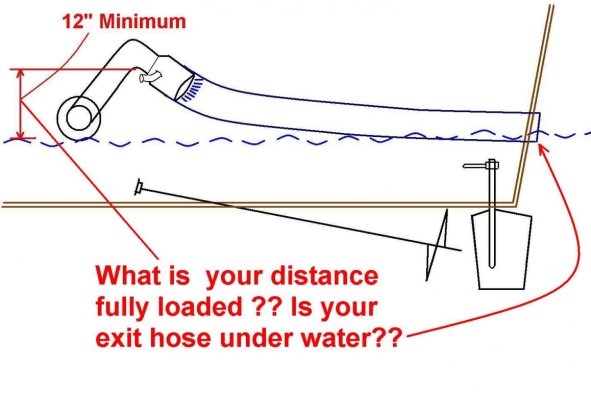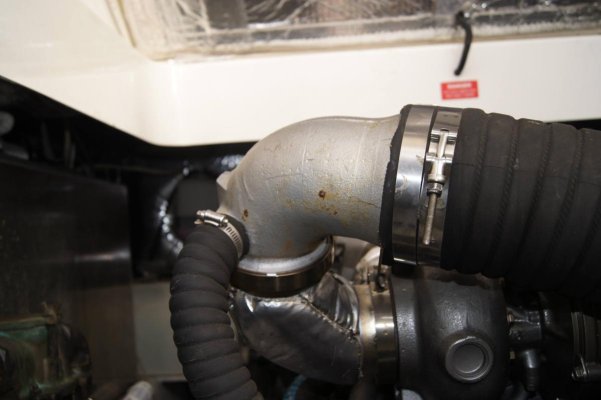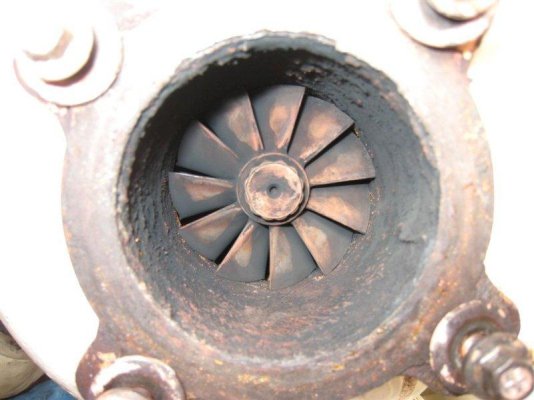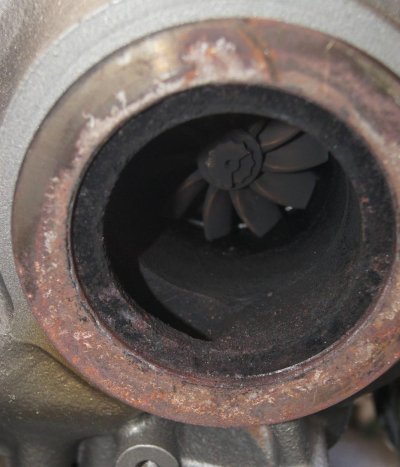Several of you have asked for my prepurchase engine checklist and I am happy to send you one by email. But here it is for all to see- and comment on ;-).
It covers the three Yanmar engines that are used in trawlers- the 4LH, 6LP and 6LY and is more specific to the 6LY which is what I have. But it can be used with any diesel engine. Ignore the stuff on aftercoolers if yours is naturally aspirated.
I believe that if you follow this checklist and it shows no issues, then you have a high probability of a trouble free engine. No hull surveyor will go into this much detail and some engine surveyors won't either. It does require some cooperation from the seller and if you can write things like removal of the dry exhaust elbow into your purchase contract, so much the better whether you do it or an engine surveyor does it.
Look at the engine room. Is is neat and clean. Note spill over exhaust height- see diagram attached. Should be 12” or better. If not you can remove first dry elbow from the exhaust turbo and look inside. See attached pic from my engine for good turbo. Any corrosion products, ie rough surface is very bad as shown in the pic from a Cummins B turbo, the one with the mounting bolts shown.
Dip your finger in coolant and look at color. Green is bad. Orange, yellow or clear is probably ok. Look for used container on board and see if it is ok for aluminum or says it is has low or no silicates. Old style high silicate antifreeze leads to erosion of aluminum exhaust elbow and failures.
Pull a couple of zinc locations- main heat exchanger, intercooler, oil cooler and check for zinc. No zincs tells you it wasn’t maintained very well.
Start the engine from dead cold. Should start in a couple of seconds. Exhaust might be smoky for the first minute then should clear or at least light with a white wisp of smoke.
Let it warm up then calibrate the dash tach with a photo tach at about 2,000 rpm. A photo tach is an electronic tachometer that uses a photo cell to count the flashes of a white stripe of tape that you paste to the engine front pulley. It is very accurate and dash tachs can be 200 rpm off. Note the pct difference and apply that to later readings. After it gets to operating temps, shoot the thermostat housing with an IR gun and compare to dash temp gauge and note difference for later.
If blowby tube is easily accessible put your hand behind it and feel for exhaust pulses. Should be essentially none. The blowby tube is a 3/4” diameter hose from the rocker cover or front gear case that on the 6LY terminates just above the foam air cleaner.
Go for seatrial. Run up to wot for a couple of minutes and note engine rpm, engine temp. Should hit 3,900 rpm for the 6LP engine, 3,400 for 6LY or 4LH Yanmars. Temp can rise about 10 deg but should stay at 205 or less. Throttle back to 2,800 rpm and check blowby again. Some is ok, heavy that blows your hand back is not ok. If you can’t find the blowby tube on your engine, take off oil filler cap while underway and feel for exhaust pulses. Do it quickly because oil will probably be splashing up. Significant exhaust pulses indicates bad piston rings or valve guides.
At moderate cruising rpm, say 2,800, shoot outlet air temp from intercooler and inlet seawater temp. Difference should not be higher than 20 deg. Any higher indicates significant air side fouling.
Check for vibration underway- prop shaft shouldn’t vibrate more than a few thousandths of an inch. Check for seawater drips from shaft log.
At dock after shutdown look for any new leaks- oil, sea water, antifreeze. Pull an oil sample for analysis. One sample won’t tell you much about wear metals, but it will tell you if seawater or antifreeze has gotten inside. An indication of seawater is high sodium-Na with potassium-K about 1/30 of Na- natural seawater. Na without K is probably glycol.
Some no go criteria, or at least a serious price adjustment:
Engine revving less than 3,400 with clean bottom. Means it probably has been overloaded some of its life.
Overheating
Corrosion on turbo. Big problem- cost to replace turbo, engine may have salt water corrosion and cost to redo exhaust system.
High delta T on intercooler. Depends on how bad. Cleaning will fix it but if it really was high, could have damaged engine.
No zinc left. This is one that indicates potential corrosion of exchanger metals reducing their life or at worst a pinhole is already jeopardizing the engine.
The middle pic is a typical Yanmar exhaust set up on my 6LY. The first elbow from the turbo is insulated, ie not water jacketed. It then mates with the injection elbow and you can see the water hose entering at the left. There are two problems. The height is 8” and should be a minimum of 12”. The second is that the injection elbow is oriented so that it always has water inside it, even when the engine shuts down. If the inner wall fails, the water will drain back into the turbo. I fixed both of these problems with an extension and a third elbow. The boat you are looking at may not have room for this.
David
It covers the three Yanmar engines that are used in trawlers- the 4LH, 6LP and 6LY and is more specific to the 6LY which is what I have. But it can be used with any diesel engine. Ignore the stuff on aftercoolers if yours is naturally aspirated.
I believe that if you follow this checklist and it shows no issues, then you have a high probability of a trouble free engine. No hull surveyor will go into this much detail and some engine surveyors won't either. It does require some cooperation from the seller and if you can write things like removal of the dry exhaust elbow into your purchase contract, so much the better whether you do it or an engine surveyor does it.
Look at the engine room. Is is neat and clean. Note spill over exhaust height- see diagram attached. Should be 12” or better. If not you can remove first dry elbow from the exhaust turbo and look inside. See attached pic from my engine for good turbo. Any corrosion products, ie rough surface is very bad as shown in the pic from a Cummins B turbo, the one with the mounting bolts shown.
Dip your finger in coolant and look at color. Green is bad. Orange, yellow or clear is probably ok. Look for used container on board and see if it is ok for aluminum or says it is has low or no silicates. Old style high silicate antifreeze leads to erosion of aluminum exhaust elbow and failures.
Pull a couple of zinc locations- main heat exchanger, intercooler, oil cooler and check for zinc. No zincs tells you it wasn’t maintained very well.
Start the engine from dead cold. Should start in a couple of seconds. Exhaust might be smoky for the first minute then should clear or at least light with a white wisp of smoke.
Let it warm up then calibrate the dash tach with a photo tach at about 2,000 rpm. A photo tach is an electronic tachometer that uses a photo cell to count the flashes of a white stripe of tape that you paste to the engine front pulley. It is very accurate and dash tachs can be 200 rpm off. Note the pct difference and apply that to later readings. After it gets to operating temps, shoot the thermostat housing with an IR gun and compare to dash temp gauge and note difference for later.
If blowby tube is easily accessible put your hand behind it and feel for exhaust pulses. Should be essentially none. The blowby tube is a 3/4” diameter hose from the rocker cover or front gear case that on the 6LY terminates just above the foam air cleaner.
Go for seatrial. Run up to wot for a couple of minutes and note engine rpm, engine temp. Should hit 3,900 rpm for the 6LP engine, 3,400 for 6LY or 4LH Yanmars. Temp can rise about 10 deg but should stay at 205 or less. Throttle back to 2,800 rpm and check blowby again. Some is ok, heavy that blows your hand back is not ok. If you can’t find the blowby tube on your engine, take off oil filler cap while underway and feel for exhaust pulses. Do it quickly because oil will probably be splashing up. Significant exhaust pulses indicates bad piston rings or valve guides.
At moderate cruising rpm, say 2,800, shoot outlet air temp from intercooler and inlet seawater temp. Difference should not be higher than 20 deg. Any higher indicates significant air side fouling.
Check for vibration underway- prop shaft shouldn’t vibrate more than a few thousandths of an inch. Check for seawater drips from shaft log.
At dock after shutdown look for any new leaks- oil, sea water, antifreeze. Pull an oil sample for analysis. One sample won’t tell you much about wear metals, but it will tell you if seawater or antifreeze has gotten inside. An indication of seawater is high sodium-Na with potassium-K about 1/30 of Na- natural seawater. Na without K is probably glycol.
Some no go criteria, or at least a serious price adjustment:
Engine revving less than 3,400 with clean bottom. Means it probably has been overloaded some of its life.
Overheating
Corrosion on turbo. Big problem- cost to replace turbo, engine may have salt water corrosion and cost to redo exhaust system.
High delta T on intercooler. Depends on how bad. Cleaning will fix it but if it really was high, could have damaged engine.
No zinc left. This is one that indicates potential corrosion of exchanger metals reducing their life or at worst a pinhole is already jeopardizing the engine.
The middle pic is a typical Yanmar exhaust set up on my 6LY. The first elbow from the turbo is insulated, ie not water jacketed. It then mates with the injection elbow and you can see the water hose entering at the left. There are two problems. The height is 8” and should be a minimum of 12”. The second is that the injection elbow is oriented so that it always has water inside it, even when the engine shuts down. If the inner wall fails, the water will drain back into the turbo. I fixed both of these problems with an extension and a third elbow. The boat you are looking at may not have room for this.
David




